The Thraupidae are a family of passerine birds found in the Americas. About 60% of tanagers live in South America, and 30% of these species live in the Andes. Most species are endemic to a relatively small area. In addition to "tanagers", dacnis, finches, flowerpiercers, honeycreepers, seedeaters, and many other diversely named species are included in Thraupidae. The tangara genus includes some of the most spectacularly colored THE WORLD BIRDS.
Tanagers are omnivorous, and their diets vary from genus to genus. They have been seen eating fruits, seeds, nectar, flower parts, and insects. Many pick insects off branches. Other species look for insects on the undersides of leaves. Yet others wait on branches until they see a flying insect and catch it in the air.
Some birds that are called Tanagers are actually in the Cardinal family Cardinalidae.
Genus Chlorophanes - 1 species
Honeycreeper, Green Chlorophanes spiza Found: southern Mexico south to Brazil
1, 2) Juvenile| 3 - 6) Female 7, 8, 9) Male

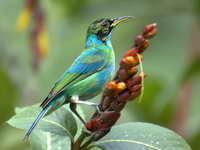
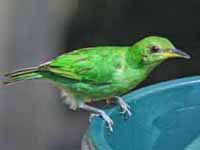
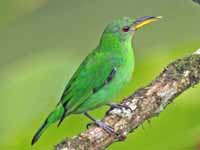
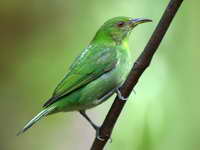
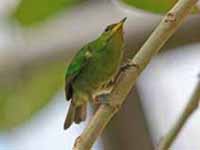
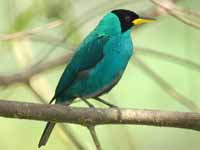

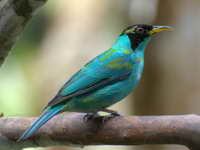
Genus Cyanerpes
The honeycreepers have long curved bills which they use to access nectar. The males are typically purple-blue; females greenish. Other honeycreeps are in genus Chlorophanes.
Honeycreeper,_Shining Cyanerpes lucidus Found: Mexico, Central America, Columbia
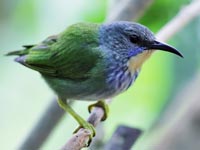
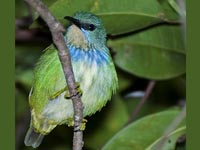
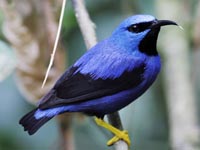
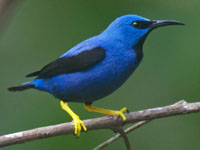

Honeycreeper, Purple also Yellow-legged Honeycreeper Cyanerpes caeruleus Found: northern South America
1, 2, 3) Female 4 - 7) Male
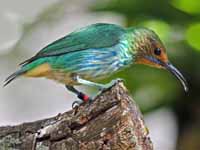
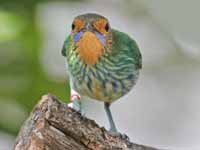




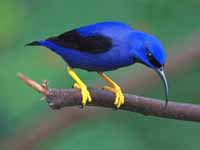
Honeycreeper,_Red-legged Cyanerpes cyaneus Found: Mexico south to Bolivia, Brazil
1 - 4) Female 5 - 8) Male
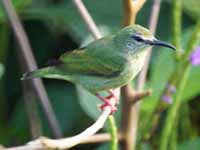
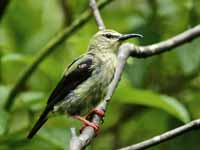



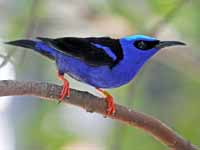
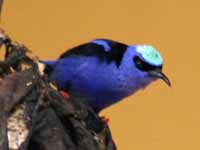
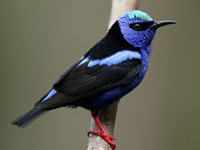
Genus Dacnis
Dacnis,_Black-faced Dacnis lineata Found: Amazon region of northern South America
1) Female 2, 3) Male 4) Male - D. i. egregia is sometimes consider species Yellow-tufted Dacnis.
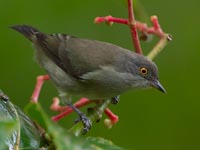
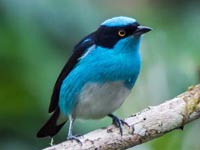
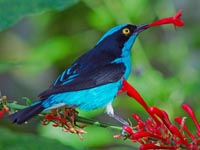
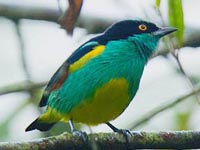
Dacnis,_Black-legged Dacnis nigripes Found: southeast Brazil
1, 2) Female 3, 4) Male
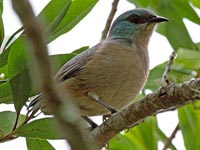
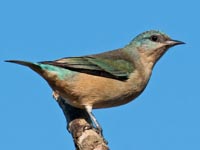
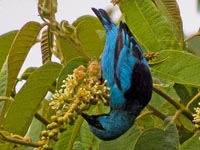
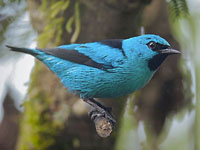
Dacnis, Blue also Turquoise Honeycreeper Dacnis cayana Found: Central and South America
1 - 4) Female 5 - 8) Male
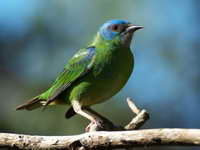
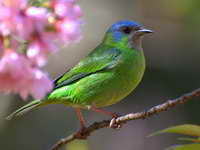
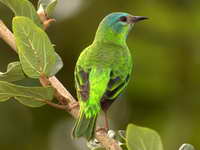

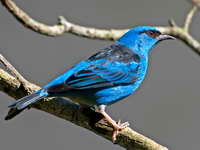
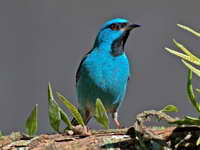


Dacnis,_Scarlet-breasted Dacnis berlepschi Found: Columbia, Ecuador
1) Pair 2) Male

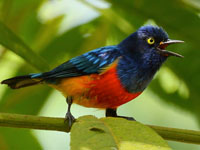
Dacnis,_Scarlet-thighed Dacnis venusta Found: Costa Rica, Panama, Columbia, Ecuador
1) Female 2) Male
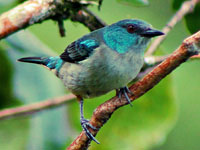
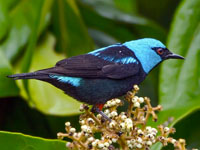
Dacnis,_Turquoise Dacnis hartlaubi Found: Columbia
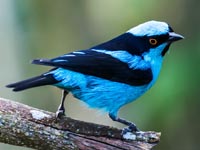
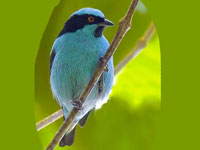
Dacnis,_Viridian Dacnis viguieri Found: northwest Columbia, eastern Panama
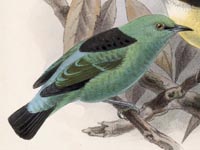
Dacnis,_White-bellied Dacnis albiventris Found: Brazil, Colombia, Ecuador, Peru, Venezuela
1) Female 2) Male
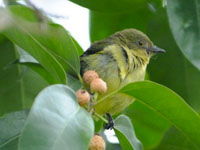
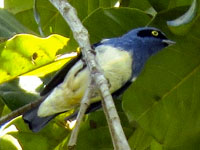
Dacnis,_Yellow-bellied Dacnis flaviventer Found: Bolivia, Brazil, Columbia, Ecuador, Venezuela
1) Pair 2) Female 3, 4) Male
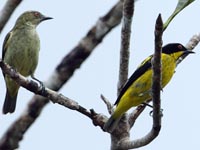

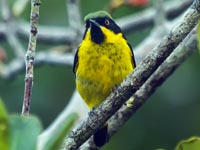
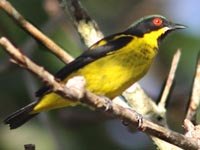
Genus Xenodacnis - 1 species
Dacnis,_Tit-like Xenodacnis parina Found: Ecuador, Peru
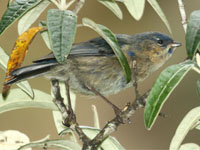
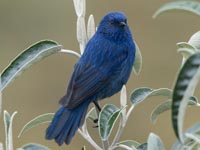
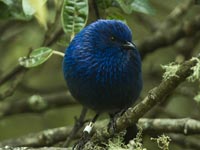
Tanagers are omnivorous, and their diets vary from genus to genus. They have been seen eating fruits, seeds, nectar, flower parts, and insects. Many pick insects off branches. Other species look for insects on the undersides of leaves. Yet others wait on branches until they see a flying insect and catch it in the air.
Some birds that are called Tanagers are actually in the Cardinal family Cardinalidae.
Genus Chlorophanes - 1 species
Honeycreeper, Green Chlorophanes spiza Found: southern Mexico south to Brazil
The male Green Honeycreeper has mainly blueish-green plumage; black head; mostly yellow bill. The female is green. It is found in the tropical New World from southern Mexico south to Brazil, and on Trinidad.
Image by: 1, 7) New Jersy Birds 2, 5, 8, 9, Dario Sanches - Brazil 3) Sandy
Cole - North
Carolina Zoo
4) Jerry Oldenettel - Costa Rica 6) Dick Daniels - North
Carolina Zoo 1, 2) Juvenile| 3 - 6) Female 7, 8, 9) Male









Genus Cyanerpes
The honeycreepers have long curved bills which they use to access nectar. The males are typically purple-blue; females greenish. Other honeycreeps are in genus Chlorophanes.
Honeycreeper,_Shining Cyanerpes lucidus Found: Mexico, Central America, Columbia
The male Shining Honeycreeper has mainly blue plumage; black lores, throat, wings. Female has green upperparts; buffy throat, belly; streaked with green and light blue on breast. Both have yellow legs.
Image by: 1, 3) Nick Athanas - Panama 2) MauricioCr 4) Jan_Axel - Panama 5) Aaron_Maizlish - Panama




Honeycreeper, Purple also Yellow-legged Honeycreeper Cyanerpes caeruleus Found: northern South America
The male Purple Honeycreeper has purple plumage; black wings, eye patch, throat; long sharply curved bill; yellow legs. Female and juvenile have green upperparts; green-streaked yellowish-buff underparts; cinnamon throat with blue moustachial stripe.
Similar to: male Blue Dacnis. Honeycreeps have a much longer bill than Blue Dacnis.
Similar to: male Red-legged Honeycreeper. The male Purple Honeycreeper has yellow legs; black throat; male Red-legged Honeycreeper has red legs; no black throat patch.
Image by: 1, 2, 4, 5, 6) Dick Daniels - Butterfly World - Florida 3, 7)
New Jersy BirdsSimilar to: male Blue Dacnis. Honeycreeps have a much longer bill than Blue Dacnis.
Similar to: male Red-legged Honeycreeper. The male Purple Honeycreeper has yellow legs; black throat; male Red-legged Honeycreeper has red legs; no black throat patch.
1, 2, 3) Female 4 - 7) Male







Honeycreeper,_Red-legged Cyanerpes cyaneus Found: Mexico south to Bolivia, Brazil
The breeding male Red-legged Honeycreeper is violet-blue with black wings; turquoise crown; red legs. Nonbreeding male mainly greenish with black wings. The female are mainly green with paler streaked underparts; brown legs.
Similar to: male Purple Honeycreeper. The male Purple Honeycreeper has yellow legs; black throat; male Red-legged Honeycreeper has red legs; no black throat patch.
Image by: 1) New Jersy Birds 2) David Cook - Panama 3) Amy McAndrews - Mexico 4) Nick Athanas - Columbia 5, 6) Dick Daniels - Butterfly World,
Florida 7) Dick - Boquette, Panama 8) Aaron_Maizlish - PananaSimilar to: male Purple Honeycreeper. The male Purple Honeycreeper has yellow legs; black throat; male Red-legged Honeycreeper has red legs; no black throat patch.
1 - 4) Female 5 - 8) Male








Genus Dacnis
Dacnis,_Black-faced Dacnis lineata Found: Amazon region of northern South America
The male Black-faced Dacnis has mainly black upperparts; black face; blue crown; blue underparts except for white or yellow belly; yellow eyes. Female has mainly greenish-olive upperparts; paler underparts; yellow eyes.
Similar to: Turquoise Dancis. Male Black-faced Dacnis has white belly; male Turquoise Dacnis has blue belly.
Image by: 1) Joao_Quental 2) Nick Athanas - Ecuador 3) Luis_Esteves 4) Francesco_Veronesi - EcuadorSimilar to: Turquoise Dancis. Male Black-faced Dacnis has white belly; male Turquoise Dacnis has blue belly.
1) Female 2, 3) Male 4) Male - D. i. egregia is sometimes consider species Yellow-tufted Dacnis.




Dacnis,_Black-legged Dacnis nigripes Found: southeast Brazil
The male Black-legged Dacnis has mainly turquoise-blue plumage; small black throat-patch; black upper-mantle; mostly black wings with blue fringe; grayish-black legs. Female has brownish-olive upperparts; tinged greenish-blue fore-crown; cheeks, rump; dull buff underparts.
Image by: 1, 3) Carlos_Henrique 2) Dario_Sanches 4) Cornell_Univ's_Neotropical_Birds_Online - Sergio_Gregorio_da_Silva1, 2) Female 3, 4) Male




Dacnis, Blue also Turquoise Honeycreeper Dacnis cayana Found: Central and South America
This is not a honeycreeper.
The male Blue Dacnis has mainly turquoise-blue body with black upperback; black eye patch, throat; short slightly curved bill. The females and juveniles are mainly green upperparts; lighter green underparts; blue head; green-edged brown wings.
Similar to: Turquoise Dacnis. Male Blue Dacnis has darker blue than Turquoise Dacnis and also has large black patch on throat.
Similar to: male Purple Honeycreeper. Honeycreeps have a much longer bill than Blue Dacnis.
Image by: 1, 2, 3, 5, 6)
Dario Sanches 4, 7) Claudio Timm in Rio Grande
do Sul, Brazil
7) Dick Daniels - San Diego Zoo 8) Dick - Soberania National Park, PanamaThe male Blue Dacnis has mainly turquoise-blue body with black upperback; black eye patch, throat; short slightly curved bill. The females and juveniles are mainly green upperparts; lighter green underparts; blue head; green-edged brown wings.
Similar to: Turquoise Dacnis. Male Blue Dacnis has darker blue than Turquoise Dacnis and also has large black patch on throat.
Similar to: male Purple Honeycreeper. Honeycreeps have a much longer bill than Blue Dacnis.
1 - 4) Female 5 - 8) Male








Dacnis,_Scarlet-breasted Dacnis berlepschi Found: Columbia, Ecuador
The male Scarlet-breasted Dacnis has blue upperparts, upper-breast; silver-blue rump; scarlet lower-breast grading to buff on lower belly Female has brown upperparts; buffy underparts; with red breast-band. Both sexes have yellow eyes.
Image by: 1, 2) Cornell_Univ's_Neotropical_Birds_Online - Silvia_Faustino_Linhare. Robert_Johnson1) Pair 2) Male


Dacnis,_Scarlet-thighed Dacnis venusta Found: Costa Rica, Panama, Columbia, Ecuador
The male Scarlet-thighed Dacnis has mainly black plumage; turquoise head with black lores; turquoise center of back, rump; thighes are scarlet, but usually hidden. Female has bluish rump; bluish tinge to head, shoulders; buffy underparts.
Image by: 1) David_Rodriguez_Arias - Costa Rica 2) Cornell_Univ's_Neotropical_Birds_Online - Cyn_Vargas 1) Female 2) Male


Dacnis,_Turquoise Dacnis hartlaubi Found: Columbia
The male Turquoise Dacnis mainly blue plumage; black mask, nape, mantle, wings, tai, throat; pale blue crown; yellow eyes. Female has dull brown upperparts; grayer head; grayish underparts becoming yellowish on belly.
Similar to: Black-faced Dacnis. Male Black-faced Dacnis has white belly; male Turquoise Dacnis has blue belly.
Similar to: Blue Dacnis. Male Blue Dacnis has darker blue than Turquoise Dacnis and also has large black patch on throat.
Image by: 1) Nick Athanas 2) Cornell_Univ's_Neotropical_Birds_Online - Dubi_ShapiroSimilar to: Black-faced Dacnis. Male Black-faced Dacnis has white belly; male Turquoise Dacnis has blue belly.
Similar to: Blue Dacnis. Male Blue Dacnis has darker blue than Turquoise Dacnis and also has large black patch on throat.


Dacnis,_Viridian Dacnis viguieri Found: northwest Columbia, eastern Panama
The male Viridian Dacnis has mainly green plumage; purple lower back, rump; black mantle, lores, flight feathers. Female has mainly olive plumage; dark brown to black lores, wings, flight feathers. Both have gray legs, yellow eyes.
Image by: 1) John_Gerrard_Keulemans
Dacnis,_White-bellied Dacnis albiventris Found: Brazil, Colombia, Ecuador, Peru, Venezuela
The male White-bellied Dacnis has mainly cobalt blue upperparts; blue head with black mask, wings; yellow eyes; blue throat, upper-breast; white lower-breast, belly. Female has yellow-olive upperparts; slightly brighter underparts.
Image by: 1, 2) Cornell_Univ's_Neotropical_Birds_Online - Tomaz Melo, Eduardo_Patrial1) Female 2) Male


Dacnis,_Yellow-bellied Dacnis flaviventer Found: Bolivia, Brazil, Columbia, Ecuador, Venezuela
The Yellow-bellied Dacnis has red eyes. Male has mainly black upperparts; greenish crown; yellow underparts. Female dull greenish-olive.
Image by: 1, 3) Nick Athanas - Ecuador, Columbia 2) Cornell_Univ's_Neotropical_Birds_Online - Roger_Alman 4)Jorge_Montejo - Brazil1) Pair 2) Female 3, 4) Male




Genus Xenodacnis - 1 species
Dacnis,_Tit-like Xenodacnis parina Found: Ecuador, Peru
The male Tit-like Dacnis has blue plumage. Female has largely blue upperparts; browner over mantle; blue crown; pale orange-rufous underparts.
Image by: 1) Tony_Castro - Ecuador 2) Gary_Clark - Ecuador 3) Francesco_Veronesi - Ecuador

